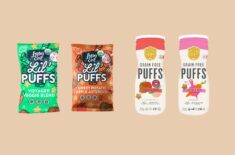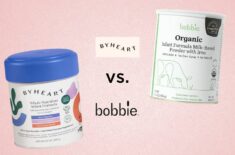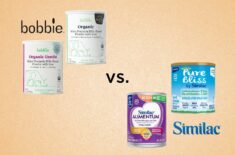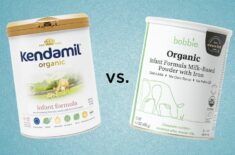Overview
Here’s a fun fact: According to ancient records, cheese has been around for over 4,000 years. (1)
Despite being an ancient food, cheese remains popular to this day. Amazingly, the US produced 13.25 billion pounds of cheese in 2020 alone. (2)
While it’s estimated that people in the US consume as much as 40.2 lbs of cheese a year, you might be curious whether it can also be a safe and healthy food to give your baby in BLW (baby-led weaning). (2)
Here’s good news, mama: Yes, cheese can be one of the solid foods you can give your little one.
Your next questions might be:
“What kind of cheese can my baby eat?”
“When can I introduce cheese to my baby?”
“Can my baby eat shredded or raw cheese?”
“How do I give cheese to my baby?”
Let’s find out below.
What’s BLW?
You might have heard about BLW from bloggers or your friends, but what is it about?
BLW is an approach to starting solids wherein your little one takes the lead, chooses from the baby food you prepare, and eats to their heart’s content.
Finger foods are encouraged in baby-led weaning, but you have to prepare everything according to their age and developmental milestones. It can help reduce BLW choking risks.
Top Reasons To Serve Cheese In BLW
Nutrition Facts
There are many types of cheese. Their nutrients vary, but all are excellent sources of calcium that your baby needs to grow strong bones, teeth, and muscles. (3)
Other nutrients found in cheese can include:
- Vitamin A – it’s important in growth, healthy vision, immunity, and reduced risks for cancer, heart disease, and acne. (4)
- Vitamin B12 – an essential nutrient for nerve function, DNA production, cell metabolism, and red blood cell formation (5)
- Vitamin D – it’s for building and maintaining healthy bones, supporting brain health, and improving brain cell activity (6)
- Riboflavin (vitamin B2) – it’s for improving cell function, growth, and development (7)
- Niacin (vitamin B3) – it’s an important nutrient for cell function and development, and for converting food into energy (8)
- PUFAs (polyunsaturated fatty acids) and omega-3 fatty acids – it’s essential for brain development (9)
Swiss Cheese
A portion (3.5 oz) of Swiss cheese can contain the following: (10)
- Energy: 393 kcal
- Carbohydrates: 1.44 g
- Proteins: 27 g
- Fat: 31 g
- Calcium: 890 mg
- Vitamin A: 292 mcg
- Vitamin B12: 3.02 mcg
- Riboflavin: 0.303 mg
- Niacin: 0.06 mg
- PUFAs: 1.14 g
Cheddar Cheese
A portion (3.5 oz) of cheddar cheese can contain the following: (11)
- Energy: 429 kcal
- Carbohydrates: 0 g
- Proteins: 25 g
- Fat: 35.71 g
- Calcium: 714 mg
- Vitamin A: 1,786 IU
- Fatty acids: 21.43 g
What Kind Of Cheese Can My Baby Eat?
Organic cheese from grass-fed cows can contain higher amounts of omega-3 fatty acids, healthy fats that can support brain development. (12)
The following are some types of cheese that can be ideal for your baby, as long as it’s made from pasteurized milk and is full-fat:
- Swiss cheese
- Fresh mozzarella (not low-moisture mozzarella)
- Parmesan
- Romano
- Cottage cheese
- Cream cheese
- Ricotta
- Goat cheese
- Colby
- Cheddar (mild)
- Monterey Jack
We also recommend offering your baby only certified organic cheeses made without hormones or antibiotics.
Food Safety With Cheese
Is Cheese A Choking Hazard?
The CDC (Centers for Disease Control and Prevention) considers large chunks of cheese, particularly string cheese, among the most common choking hazards. (13)
It’s a good idea to avoid serving cheese in chunks or cubes to minimize choking risks.
Avoid sticky, stringy, or rubbery cheese.
For example, while fresh mozzarella is soft and can be easier to swallow, the other kind (low-moisture mozzarella) isn’t a good choice because it’s rubbery and sticky, making it difficult for your baby to eat.
It’s important to cut and prepare cheese according to your child’s age or developmental milestones to reduce choking risks. You can learn more about this below.
Is Cheese An Allergen?
Yes, cheese is considered a common allergen because it’s a dairy product.
Cow’s milk protein allergy is among the most common food allergies in young children, affecting up to 3% of children in their first year of life. (14)
Research shows that milk proteins such as casein might cause more serious reactions. Whey components alpha-lactalbumin and beta-lactalbumin can also trigger similar reactions. These can be detected in a blood test called a component test. (15)
Although fatality is rare, dairy allergy is also a common cause of food-induced anaphylaxis (severe, potentially life-threatening allergic reaction). So, it’s essential to closely watch for signs of allergies when you introduce milk and other dairy products. (14)
Symptoms can occur within hours or several days after your baby’s first time to consume these foods: (16)
- Itchy, watery, and/or swollen eyes
- Hives
- Wheezing
- Coughing
- Hoarseness
- Throat tightness
- Trouble breathing
- Stomach upset
- Vomiting
- Diarrhea
- Lightheadedness or loss of consciousness from a drop in blood pressure
The good news, mama, is that 85-90% of children outgrow a dairy allergy by three years of age. (17)
Early Allergen Introduction
Studies show that early introduction to allergens such as peanuts, eggs, and milk at around four to six months of age can reduce your baby’s risk of developing food allergies. (18)(19)
Because casein allergy is genetic, babies who have family members with food allergies are considered high-risk, even if they haven’t been diagnosed with any food allergies themselves. (18)(20)
However, be sure to first get your pediatrician’s approval before starting your baby on milk or dairy products like cheese.
Can I Introduce Cheese If There’s A Family History Of Dairy Intolerance?
Like milk allergies, dairy or lactose (a sugar in milk) intolerance can be genetic. It’s rarely life-threatening, but lactose intolerance can bring discomfort to your baby. (21)
So, it’s best to exercise caution and get your pediatrician’s approval before introducing cheese if there’s a family history of dairy intolerance.
It’s easy to confuse milk allergy and lactose or dairy intolerance because the same foods can trigger them. However, an allergy is the immune system’s response to an allergen, while food intolerance doesn’t involve the immune system.
Lactose intolerance can happen because your baby’s tummy doesn’t produce enough lactase, an enzyme that breaks down lactose.
Because milk and dairy products aren’t properly digested, lactose intolerance can lead to the following symptoms: (21)
- Nausea
- Gas
- Bloating
- Cramps
- Diarrhea
- Swelling in the tummy
- failure to gain weight
- Frothy and watery stools
- Diaper rash (inflamed, bright red skin on your baby’s bottom)
- Crying when pooping
- Irritability
Note that breast milk can also cause lactose intolerance. You might notice that your baby won’t settle during feeding time if you’re breastfeeding.
Can Babies Eat Raw Cheese?
Unpasteurized or raw cheese and dairy products can put your child at risk for a serious bacterial infection, usually from Listeria. Avoid giving them to your baby. (22)(23)
Pasteurized cheeses are made from milk treated at mild heat to remove pathogens, making them safer for human consumption.
Unpasteurized and pasteurized cheeses can look the same. Be sure to check for “pasteurized milk” on the ingredient list. Avoid cheese made from “raw milk.”
Types Of Cheese To Avoid
Surprisingly, some cheese products made from pasteurized milk can still be contaminated with Listeria bacteria.
The CDC believes that this can be due to unsanitary conditions in their production facilities, or the cheese-making process might lead to contamination. (23)
That’s why the CDC recommends avoiding the following soft cheeses: (23)
- Brie
- Camembert
- Queso fresco
- Queso blanco
- Panela (queso panela)
- Blue-veined cheese
- Feta
Do You Have To Cook Cheese For Babies?
No. Your baby can eat uncooked cheese as long as it’s pasteurized and not included in the types of cheese to avoid listed above.
The term “raw cheese” refers to cheese made from raw, unpasteurized milk. It’s not about whether it’s cooked or uncooked (as opposed to raw apples or sweet potatoes).
When Can I Introduce Cheese To My Baby?
Your baby can have cheese when they’re showing signs of readiness for solid foods around four to six months.
Be sure to choose baby-safe types of cheese (mentioned above), and get the green light first solid food introduction from your pediatrician.
Can I Give My Six-Month-Old Cheese?
The AAP (American Academy of Pediatrics) and Dietary Guidelines for Americans recommend introducing solid foods when your baby is ready, usually at around six months of age. (24)(25)
However, every child is different. Some develop more quickly than others and might be ready for solid foods by four months of age.
Remember that cheese is a common allergen. Try not to give it as your baby’s first food; choose less-allergenic, nutritious foods like fruits and veggies.
Still, you can include cheese in your baby’s meal plan with your pediatrician’s approval and if milk or other dairy-based products are successfully introduced.
How Do I Give Cheese To My Baby?
When introducing new foods, especially common allergens like cheese, start by serving small quantities. Watch closely for potential allergic reactions while your baby eats.
You can gradually increase the quantity of this food in future servings.
Introducing one food at a time can be the best way to rule out any possible allergen your baby might react to.
Ways To Serve Cheese In BLW
Can My Baby Eat Shredded Cheese?
Yes. Shredded or melted cheese can be a good choice for babies, but be sure you aren’t giving them sticky, rubbery melted cheese such as low-moisture mozzarella.
Can Babies Eat Mac And Cheese?
Yes. As long as you’ve introduced dairy and pasta, mac and cheese can be an easy-to-prepare food for your little one.
But it’s not a good idea to give this dish if you haven’t introduced both because pasta can contain gluten, another common allergen.
Always watch for any allergic reactions.
Other Ways To Serve Cheese
- Shredded or pre-shredded cheese for finger food practice
- Thin strips for easy chewing
- Melted on top of veggies, toast, pancakes, or in a grilled cheese sandwich
- Sprinkled or grated over pasta dishes (if you already introduced pasta)
You can also mix cheese with fruit and veggie purée that your baby can scoop with their fingers or a BLW-friendly spoon.
Preparing Cheese For Baby Led Weaning
For 4-6 Months Old
You can offer shredded cheese in mounds or on toast to babies around four to six months old. Avoid giving cheese in chunks or big cubes to avoid choking risks.
However, be sure that they’re showing signs of readiness for solid foods before introducing them to cheese.
And always get your pediatrician’s approval before giving any solids, especially potential allergens, to babies younger than six months of age.
How Do I Cut Cheese For My Seven-Month-Old?
A seven-month-old can self-feed with thin slices of cheese. You can reduce choking risks by avoiding cheese in chunks or big cubes.
Half-moon slices or shredded cheese toppings on toast can also be a good choice.
For 8 Months Old And Above
Continue giving cheese in thin slices because this food can be too sticky and might get stuck in your baby’s throat if given in larger slices or chunks. Avoid string cheese.
Grated or shredded cheese remains a good option at any age.
Safety Tips In Serving Cheese & Doing BLW
- Don’t allow your baby to run, crawl, or walk around while eating.
- Let your baby sit in a safe space for eating, such as a high chair with a 5-point harness (restrains legs, shoulders, and torso).
- Choose only the baby-safe types of cheese listed above.
- Cut and serve cheese appropriate for your baby’s age.
Fun Recipe: Egg And Spinach Cups With Cheese
Ingredients
- Six eggs
- 2 oz milk (breast milk or formula)
- A handful of spinach
- 1 tsp coconut or olive oil
- One regular tomato or six cherry tomatoes, diced
- One red bell pepper, minced
Preparation Instructions
- Preheat the oven (350 degrees Fahrenheit).
- Whisk the milk and eggs together until fluffy.
- Sprinkle the muffin tin with oil.
- Pour in your egg mixture, filling half of each section.
- Chop the spinach, tomatoes, and bell pepper.
- Arrange the chopped veggies in the muffin pan.
- Bake for 25 minutes.
- Cool before serving.
You can also add shredded cheese or other toppings.
Serve one or two cups of this dish to your baby, and store the rest in an airtight container in the fridge. Egg dishes can last 3-4 days in the fridge. (26)
Simply pop them in the oven to reheat for an easy breakfast and snack.
REFERENCES
(1) https://www.idfa.org/history-of-cheese
(2) https://www.agmrc.org/commodities-products/livestock/dairy/cheese-industry-profile
(3) https://www.hsph.harvard.edu/nutritionsource/cheese/
(4) https://www.mayoclinic.org/drugs-supplements-vitamin-a/art-20365945
(5) https://www.mayoclinic.org/drugs-supplements-vitamin-b12/art-20363663
(6) https://www.mayoclinic.org/drugs-supplements-vitamin-d/art-20363792
(7) https://ods.od.nih.gov/factsheets/Riboflavin-Consumer/
(8) https://ods.od.nih.gov/factsheets/Niacin-Consumer/
(9) https://www.ncbi.nlm.nih.gov/pmc/articles/PMC3819697/
(10) https://fdc.nal.usda.gov/fdc-app.html#/food-details/746767/nutrients
(11) https://fdc.nal.usda.gov/fdc-app.html#/food-details/494681/nutrients
(12) https://pubmed.ncbi.nlm.nih.gov/16702257/
(13) https://www.cdc.gov/nutrition/infantandtoddlernutrition/foods-and-drinks/choking-hazards.html
(14) https://www.ncbi.nlm.nih.gov/pmc/articles/PMC6566637/
(15) https://acaai.org/allergies/allergic-conditions/food/milk-dairy/
(16) https://kidshealth.org/en/parents/milk-allergy.html
(17) https://pubmed.ncbi.nlm.nih.gov/12487202/
(18) https://www.ncbi.nlm.nih.gov/pmc/articles/PMC6157280/
(19) https://pubmed.ncbi.nlm.nih.gov/20541249/
(20) https://www.scielo.br/j/cta/a/7H9sz75JvFs9gNYqysgZ68H/?format=pdf&lang=en
(21) https://www.foodallergy.org/resources/milk-allergy-vs-lactose-intolerance
(22) https://www.cdc.gov/nutrition/infantandtoddlernutrition/foods-and-drinks/foods-and-drinks-to-limit.html
(23) https://www.cdc.gov/listeria/prevention.html
(24) https://www.cdc.gov/nutrition/infantandtoddlernutrition/foods-and-drinks/when-to-introduce-solid-foods.html
(25) https://www.dietaryguidelines.gov/sites/default/files/2020-12/Dietary_Guidelines_for_Americans_2020-2025.pdf
(26) https://www.fda.gov/food/buy-store-serve-safe-food/what-you-need-know-about-egg-safety












